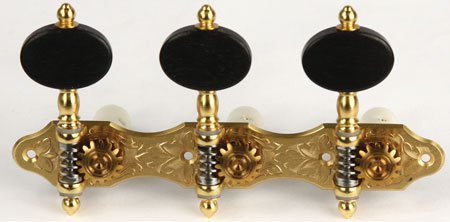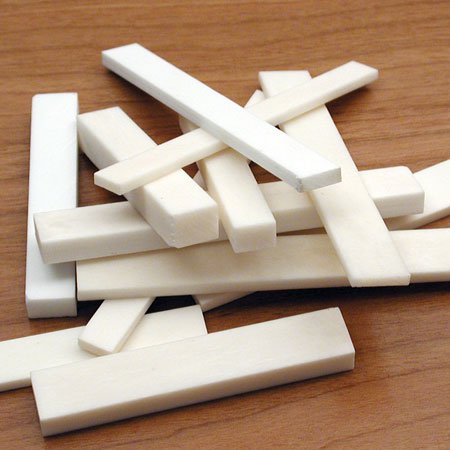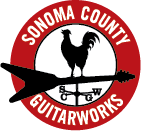No matter your skill level as a fretted instrument player, you’ll sound a heck of a lot better if you are beautifully in tune and your instrument is well intonated. When intonation is correct, the fretted notes are in tune with the open string note. One thousand years ago when we were all playing fretless lutes and ouds with rough wooden tuning pegs, being in tune depended completely on the keenness of your ear. Then, someone invented tied-on movable frets, which made playing less dependent on pitch perception. Fast forward to the present with modern tuning gears, factory-made strings (rather than the local cat’s gut), fret placement accuracy to 1/1000 of an inch, and electronic pitch detectors – the possibility of being very in tune is available to all. Let’s examine the whole string path – tuning machines, nut, strings, fret crowns, neck shape and saddles – one by one with a word thrown in about electronic tuners.
 Tuning Machines
Tuning Machines
We like beautiful handmade objects as much as anybody and the last 15 years has seen a flowering of handmade tuners. Rogers, Alessi, Graf, Robson, and Gilbert are notable makers whose tuners go for $300-$1200 (the Alessi Hauser tuners shown to the left are hand engraved in Italy, photo ref. LMI). Next are the top-notch factory tuners: Gotoh, Schaller, Hipshot, Grover, Sperzel, Waverly, Rubner, which are in the $50–$200 range. Below that are stamped out economy tuners. For playing in tune easily, your tuners should move smoothly and stay where you put them. You pay more for beauty and wooden knobs and slightly more for better tuning ratios (from 12:1 to 21:1), but the take-home lesson for our primary goal (being really in tune) is that any tuner at the $50 and up price point works about the same and that you should never suffer with less then buttery, easy-to-turn tuners. Even the relatively inexpensive ones work wonderfully and they are easy to replace.
 Nut
Nut
Leaving the tuners, the strings cross the nut. Three parameters are key to tuning ease here: 1) the free vibrating area of the string must start exactly at the fingerboard edge of the nut, 2) the string must not bind in its slot, and 3) the string slot cannot be too high off the fingerboard. For correct intonation, points 1 and 3 are critical. Because the nut is typically bone or plastic (relatively soft compared to the metal of the strings) it wears down with tuning and all three parameters will need to be adjusted occasionally.
(Nut and saddle blanks ready to be shaped for tuning perfection; photo ref. LMI)
Strings
This is the area of greatest choice in instrument shopping with way too many brands and types to list. Very broadly speaking, the differences are materials that sound brighter/darker and coatings that keep dirt off the strings and extend their usable life. Two parameters are key to our tuning pursuit: using the gauge of strings your instrument was set up for (switching from medium 56–13 to light 46–10 will affect your intonation) and keeping your strings fresh. Once you’ve played strings for 3–40 hours (depending on your sweat level and how hard you hit) or if they become corroded or won’t stay in tune, it’s time to change them.
Fret Crowns
The side view of a good fret looks like this.
 A string contacts it like this. The string should contact the fret at a tangent point, that is, at as narrow a point as is physically possible. That contact point should also be exactly in the middle of the fret.
A string contacts it like this. The string should contact the fret at a tangent point, that is, at as narrow a point as is physically possible. That contact point should also be exactly in the middle of the fret.
 A string contacts it like this. This leads to a less-than perfectly in-tune note (not referencing from the center point) and fret buzzing (a different topic).
A string contacts it like this. This leads to a less-than perfectly in-tune note (not referencing from the center point) and fret buzzing (a different topic).
Neck Shape
Under string tension (100-170 pounds of pull depending on your string gauge), the neck pulls up into a gentle curve. This curvature can be measured in thousandths of an inch. A range of 4 – 8 thousandths is normal and is set for the player’s style; much more than that can start to affect intonation.
Saddle
The saddle, like the nut and frets, terminates the string at an exact and narrow point. Like the nut and frets, if it has a flat spot, it will not play perfectly in tune. Unlike the nut and frets, which are straight lines perpendicular to the instrument’s centerline, the saddle is compensated, which means it creates individual end points for each string based on that string’s diameter and pitch. The compensation of each string’s saddle position is critical to playing in tune. The saddle is also the main determiner of the action, which is the height of the strings above the frets. Like neck shape, a range of action settings is acceptable and is set for the player’s style. However, very high action will throw the intonation off considerably.
Electronic Tuners
Lastly, each open string should be tuned to whatever note you are assigning to it with an accurate electronic tuner. These are rated in accuracy by cents, a musical measurement that is 1/100th of a half step. Look for a tuner that is rated accurate to +/- 1 cent. Clip on tuners, pedal tuners and phone app tuners all work very well. For really accurate tuning and intonation work, use a Peterson tuner or Peterson app, accurate to 1/10 of a cent.
To sum up, it’s much more pleasant to be really in tune and this can be achieved fairly easily these days with a good overall setup, fresh strings, working tuning machines and a solid electronic tuner.



